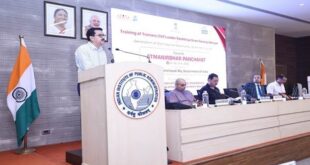- Recently, the Information and Broadcasting Ministry (I&B) informed a Malayalam-language news channel that its broadcast licence had been cancelled.
- The cancellation order cited a Home Ministry order that had denied security clearance to the channel.
- Until 2021, it had the powers to regulate content across all sectors — TV channels, newspapers and magazines, movies in theatres and on TV, and the radio — barring the internet.
- In February, 2021, the Information Technology (Intermediary Guidelines and Digital Media Ethics Code) Rules, 2021, extended its regulatory powers over internet content too, especially on digital news platforms and Over the Top (” OTT “) platforms.
- For example, the Central Board of Film Certification (CBFC) has a mandate to give any film that will be played in a theatre, a rating indicating the kind of audience it is suitable for.
- In practice, however, the CBFC has often suggested changes or cuts to a film before giving it a certification. While it isn’t the CBFC’s mandate to censor a film, it can withhold giving a rating unless the filmmaker agrees to its suggestions.
- When it comes to TV channels, the government last year came up with a three-tier grievance redressal structure for viewers to raise concerns, if any.
- A viewer can successively approach the channel, then a self-regulatory body of the industry, and finally the I&B Ministry, which can issue a show cause notice to the channel, and then refer the issue to an Inter-Ministerial Committee (IMC).
- For content on OTT platforms too, there is a similar structure.
- The ministry also has the Electronic Media Monitoring Cell, which tracks channels for any violations of the programming and advertising codes mentioned in the Cable TV Network Rules, 1994.
- Violation can lead to revocation of a channel’s uplinking licence (for sending content to a satellite) or downlinking licence (for broadcasting to viewers through an intermediary). It is these licences of MediaOne (Malayalam-language news channel) that the government revoked.
- In print, based on the recommendations of the Press Council of India, the government can suspend its advertising to a publication.
- And last year’s IT rules allowed the I&B Ministry to issue orders to ban websites based on their content.
- There are no specific laws on content allowed or prohibited in print and electronic media, radio, films or OTT platforms.
The content on any of these platforms has to follow the free speech rules of the country. Article 19(1) of the Constitution, while protecting freedom of speech, also lists certain “reasonable restrictions” including content related to:
The security of the state
- Friendly relationship with foreign states
- Public order
- Decency
- Morality etc
SOURCE: THE HINDU,THE ECONOMIC TIMES,MINT
 Chinmaya IAS Academy – Current Affairs Chinmaya IAS Academy – Current Affairs
Chinmaya IAS Academy – Current Affairs Chinmaya IAS Academy – Current Affairs



